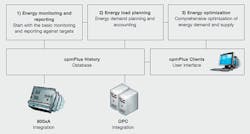Combined cycle power plants like this one can benefit from ABB's industrial energy efficiency solutions.
The case for energy efficiency improvements across large parts of industry is well known. Government agencies and public and private research has shown that there are substantial energy saving possibilities in most industrial sectors and in most regions of the world. And yet, in spite of the commercial attractiveness of these energy saving opportunities, companies are not commissioning energy saving projects and therefore are not achieving their potential to reduce energy consumption. ABB has considered the real barriers to implementation to design viable solutions to overcome many of the obstacles that exist.
The process to realizing most business improvements is sequential - recognizing the need for action, identifying the problems, delineating the improvement measures, and designing and implementing the detailed solutions. Only then will an organization realize, in this case, energy savings.
Notably, even in regions where the reduction of energy consumption and carbon emissions have been high on the agenda for many years (such as in Northern Europe), many organizations have yet to move on from the initial identification of problems &-referred to as an energy audit. Governments and utility companies have funded the provision of energy audits as a means of priming the pump and promoting energy savings but the follow-on action has not been forthcoming. Why is this?
Risk aversion to the unfamiliar
In a petrochemical plant, for example, engineers are intimately familiar with the core process technology and its relevant machinery. Those engineers are highly competent at understanding how small changes to process equipment, settings and conditions will affect plant reliability, product quality, consistency and output.
They are confident, thanks to years of experience, of making modifications to their core process plant and equally confident and accurate in predicting the outcome of those modifications. But a similar level of confidence does not exist around, for example, the on-site boiler, steam and power generation systems, the cooling water systems, the fuel gas systems and other noncore utility systems. Consequently, while the core process is operated in a high state of "une", the utility systems are often running almost the same as when they were first commissioned 20 or 30 years ago. Furthermore, historically there was very little attention paid to utility process performance and there is very little metering to enable engineers and operators to truly monitor utility system performance.
Disaggregated prize
Energy savings, while significant in the aggregate, are rarely concentrated in a few discrete projects, improvement measures or locations in a complex plant. The energy saving prize is "disaggregated" - spread across 50, 100 or more discrete interventions. Complex process plants are highly asset intensive and such organizations frequently have comprehensive capital project processes to take ideas through a front-end-loaded screening process and through a highly controlled project execution process. The disaggregated nature of energy saving projects leads to a position that the "prize" is not worth the effort of invoking the capital project process 50, 100 or more times. Consequently, energy saving projects are often not implemented.
Capability gaps
An effect of the focus on a company's core technology and manufacturing processes is that there is far less competency in today's lean manufacturing organizations to support noncore technologies. It is rare to find well-supported energy engineers in most manufacturing organizations. With a lack of energy engineering expertise in-house, the ability of organizations to execute energy saving projects is significantly reduced and, once again, energy saving projects are not implemented.
Biased resource allocation
Businesses, investors and markets are heavily focused on revenue growth. This focus percolates down into two functions within manufacturing businesses. Sales departments are focused on both market share growth and product price improvement, and production departments are focused on production output growth, to feed the growth of market share - assuming the market size is static or growing. At an engineering level this leads to a focus on plant output and de-bottlenecking and it doesn't take long for capital to be preferentially allocated to projects that help achieve this outcome, even though there are higher return projects available in cost reduction areas such as energy efficiency. Energy saving projects are, once again, not implemented.
1 ABB's Extended Automation System 800xA increases energy efficiency, asset utilization, energy savings and operator effectiveness
Information flow
It is unusual for changes to be made to businesses or production facilities if it is not possible to demonstrate to stakeholders that the changes promised from the investment have actually been delivered. The phrase "you can't manage what you can't measure" seamlessly translates into "we won't invest if we can't measure." Improvement implies that the performance after the investment is better than the performance before the investment and that, in turn, implies that it is possible to measure performance. With poor or nonexistent metering on many utility and energy systems, project opportunities cannot get off first base and don't get implemented.
But industrial energy savings is not due to lack of technology. In fact, the International Energy Agency published a report in 2009 on energy efficiency in the petrochemical sector, which highlighted that there is a potential to improve energy efficiency by 35% across the global petrochemical sector from the adoption of existing best practice technology and other technologies such as combined heat and power and plastics recycling [1]. The technology already exists to deliver substantial improvements in industrial energy efficiency across most sectors ➔ 1 - 2. The problem is that it is not being implemented.
2 ABB low-voltage drives improve process efficiency, reduce energy consumption and improve productivity
Overcoming barriers
ABB's response to the issues presented above is to offer a wholly different means of implementing energy saving projects in industry. By accessing ABB's resources, organizations can systematically overcome the barriers to energy saving project implementation.
Risk aversion to the unfamiliar
ABB will guarantee the economic outcome of energy projects to assure the customer of a measurable EBITDA (earnings before interest, taxes, depreciation, and amortization) improvement. ABB has the broad technical expertise required to assume the performance risk for the solutions it implements, thereby overcoming issue of risk aversion to the unfamiliar. This includes energy specialists, change management practitioners, project managers, project estimators and planners, process engineers and functional engineering specialists.
Disaggregated prize
ABB will aggregate multiple minor projects and interventions into a major project that creates both visibility and materiality. By bundling individual interventions into a single, larger contract, the customer no longer has to implement a "heavy duty" project process on multiple small projects but can focus on its own production-related projects and leave ABB to worry about the detail of each of the energy-saving interventions.
Capability gaps
ABB has deep energy optimization experience across both power and heat systems, as well as demonstrated ability to implement turnkey solutions in industry. As with the solution to the risk aversion barrier, ABB's technical expertise is leveraged to overcome capability gaps in customer organizations. ABB's teams are backed up by appropriate methodologies, tools and software. Its solutions are pragmatic ones, taking into account the requirements of working in a live operating plant environment.
Biased resource allocation
Where capital is not available for energy reduction projects ABB will finance energy programs, typically over five years, through shared savings models. ABB's relationships with international financial organizations enables the creation of new financing models for energy saving projects, overcoming the customer's shortage of capital for this type of project.
Information flow
ABB possesses world leading measurement technologies and a sophisticated energy management system, cpmPlus Energy Manager. Measurement and verification (M&V) is a fundamental requirement for all performance-based contracting. ABB's cpmPlus Energy Manager's base module allows customers and ABB to record and report energy and production data in real-time - providing incontrovertible measurement data upon which to base performance related remuneration ➔ 3.
4 ArcelorMittal Fos-sur-Mer Integrated Steel Mill
Delivering market-leading solutions
ABB's approach to industrial energy efficiency solutions is breaking new ground in industry. By examining the root causes of nonimplementation of the thousands of energy saving ideas already identified by internal and external study teams across thousands of industrial sites, ABB has designed a new commercial approach to improving energy efficiency in industry. The first deliveries of this type of project are due to break ground in the second half of 2012 and will demonstrate the value of ABB's ability to "think outside the box" ➔ 4.
ABB's Energy Performance Contracting Program
ABB's program relies on corporate and general management's support of the overall commercial approach - one of partnership in the delivery of real energy savings for customers. After the conclusion of a Framework Services Agreement for the provision of Energy Services, ABB Consulting teams will engage with site General Managers following a lead set by a joint ABB-Customer program steering committee.
The approach is flexible and aims to implement a manageable number of projects that will deliver significant energy savings ➔ 5. During the offer development phase we undertake a short (one to two weeks) initial appraisal to produce a portfolio of opportunities. This gives all parties a view of what energy saving opportunities exist, their value and the applicable technologies and solutions required to access them. The appraisal is deliberately broad, capturing as much energy saving value as possible for customers, typically leads to the identification of 5 to 20 percent savings of total energy usage.
In developing the site performance contract offer we upgrade our appraisal to "investment grade", drawing on ABB's deep expertise in power and automation.
Having implemented a site performance contract ABB will engineer, procure and construct the improvements agreed with the customer (Implementation). The company commissions the systems and perform baseline and performance tests in accordance with contracted Measurement and Verification (M&V) protocols.
Where ABB's approach differs from most is that, following Implementation, the company remains involved during the service period, when the savings are delivered. The shared savings contract model ensures that long term goals are aligned; ABB and the customer are equally interested in the delivery of real energy savings over the long term.
Using its expertise, ABB has delivered energy savings across a wide range of industries and utilities. By leveraging ABB's consulting expertise and domain knowledge in power and automation customers can truly procure energy savings.
Chris Stubbs
ABB Consulting
Cheshire, United Kingdom
[email protected]
-----------------------
Reference
[1] Saygin, D., Patel, M. K., Tam, C., Gielen, D. J. (2009). Chemical and Petrochemical Sector: Potential of best practice technology and other measures for improving energy efficiency. OECD/IEA. Retrieved July 10, 2012, from http://www.iea.org/papers/2009/chemical_ petrochemical_sector.pdf








